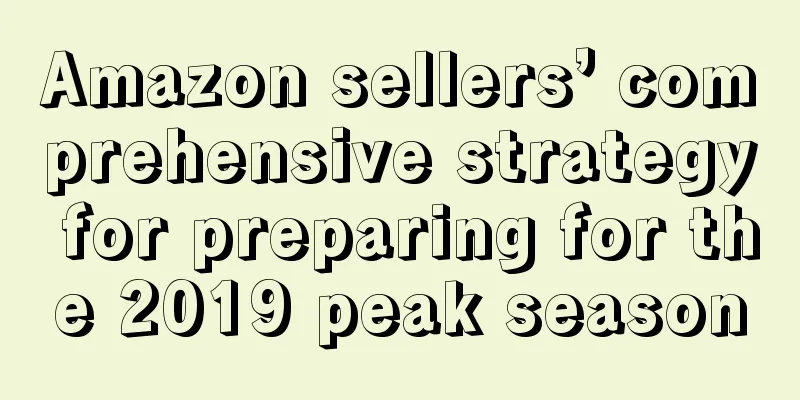There are new changes in Amazon A10 algorithm!

|
Recently, many Amazon sellers have been caught in a dilemma of unstable sales and fluctuating traffic. The reasons for this are not only the US election, multi-platform promotions, but also algorithm changes on the same platform. — 1 —New changes to Amazon's A10 algorithmMany sellers have speculated that the recent widespread unstable advertising traffic is likely due to the platform’s own algorithm adjustments. Amazon launched the much-anticipated A10 algorithm update last year, which sparked both excitement and concern among sellers. The difference between A10 algorithm and A9 algorithm: The A10 algorithm is a complex system used by Amazon to determine the ranking and display of product search results. It not only includes sales history and customer satisfaction, but also covers factors such as product relevance, price competitiveness, inventory management, and optimized keywords to determine the ranking of each product. The A9 algorithm logic is "customers generate demand - search for product keywords - platform algorithms select products and sort them for display to customers", which is a [search - product] process. In simple terms, A9 focuses on sales velocity and keywords, and sales velocity is the key to improving product rankings. The more products sell, the higher the ranking. A10 focuses more on external traffic, customer retention, dwell time (i.e. how long visitors stay on the product page), and the overall shopping experience. Amazon now values traffic from third parties, such as social media, Google, etc. Statistics show that 74% of product searches occur directly on Amazon.com, and in the context of A10, the role of external traffic becomes increasingly prominent. Sellers who can attract a large amount of external traffic can improve their ranking by up to 20%, while sellers who rely solely on Amazon's internal traffic may face a decline. — 2 —Factors that affect rankings under the A10 algorithmAfter the A10 algorithm was updated, the ranking variables changed. In addition to keywords, many other factors were also affected: 1. External Traffic : Sellers should strive to direct external traffic to product listings through blogs, social media ads, or influencer promotion. 2. Customer retention : Repeat purchases and customer satisfaction become more important. Every time a customer comes back, Amazon will provide sellers with better rankings. 3. Dwell time : The longer a customer stays on a product page, the more attractive the product is to potential buyers. 4. Click-through rate and conversion rate : If the product is clicked but fails to convert, it will have a negative impact on the ranking. The A10 algorithm favors listings with good conversion results, so optimizing pictures, titles, and bullet points becomes particularly critical. 5. Organic traffic vs. paid traffic : Unlike the A9 algorithm, which emphasizes paid advertising (PPC), the A10 algorithm places more emphasis on organic traffic. Sellers who rely entirely on Amazon PPC need to reconsider their strategies. Although PPC is still important, Amazon prefers sellers who can achieve sales through non-paid methods. — 3 —Strategies for Optimizing Amazon A10 RankingSellers should take the following actionable steps to optimize organic rankings and stay competitive: 1. Direct third-party traffic : Work hard to direct external traffic to your Amazon product listings through social media platforms, influencer marketing, and blog content. 2. Improve customer experience : By optimizing the images, bullet points, and descriptions of product listings, you can increase the depth and practicality of information, thereby extending the time customers spend on the page and increasing conversion rates. 3. Build customer loyalty : Create an atmosphere where customers come back for more by offering subscription options, creating a loyalty program, or providing follow-up discounts through email marketing. 4. Use long-tail keywords : Although short, high-volume keywords are still valuable, A10 encourages relevance. Using long-tail keywords that are closely related to customer search intent can attract more qualified traffic and increase dwell time. 5. Observe your competitors : Monitor your competitors’ activities. If you see that they are improving their rankings through external traffic, consider the channels they use and try to replicate their success. Amazon's A10 algorithm update means that sellers can no longer rely solely on PPC and sales velocity. Sellers need to learn to adapt to this new customer-centric algorithm, focusing on external traffic, customer retention, and organic engagement. |
<<: Amazon has perfected several features!
Recommend
What is Benniao Social? Benniao Social Review
Benniao Social (Shenzhen Benniao Social Technology...
What is Wise Express? Wise Express Review
Wanse Express (Shanghai Wanse Express Co., Ltd.) w...
What is Amazon Japan (Amazon.co.jp)? Amazon Japan (Amazon.co.jp) Review
Amazon Japan (Amazon.co.jp) is Japan's leading...
Big event of the week! Registration for Amazon Spring Sale opens and ends in mid-March
Registration for Amazon's Spring Sale opens, ...
What is BharatPe? Review of BharatPe
BharatPe is a QR code payment application service ...
The road to starting a business that sells billions of products
Friends who work at Amazon or live in Shenzhen may...
Performance of bathroom decoration and barbecue grill categories in the United States in Q2 2023
Recently, YipitData released the sales data of the...
Tips for sellers: How to write product descriptions that attract buyers!
For Amazon sellers, product descriptions are cruci...
What is Arctic Hunter? Arctic Hunter Review
Guangzhou Huadu District Toulang Leather Goods is ...
The incident involving Winter Olympics female athlete Gu Ailing revealed the cross-border social strategy!
The news about Gu Ailing has been all over the pla...
With Mexico’s tax reform coming, is this blue ocean market still worth entering?
Recently, some sellers received an email about the...
Cashing out 4.1 billion in 11 days! Stockpiling Made in China! Brother-in-law was criticized by 15 senior officials
While many sellers were unable to return to work d...
Millions of dollars in arrears in payments, the old freight forwarding company announced its bankruptcy!
In recent years, the freight forwarding circle has...
What is Bailaohui cross-border e-commerce? Bailaohui cross-border e-commerce review
Bailaohui Cross-border E-commerce (Shenzhen) Co., ...









